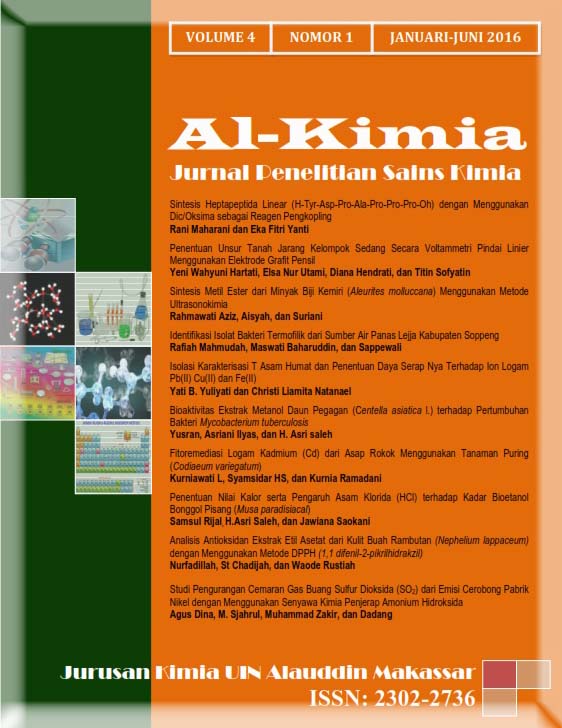Penentuan Nilai Kalor Serta Pengaruh Asam Klorida (Hcl) Terhadap Kadar Bioetanol Bonggol Pisang (Musa Paradisiacal)
Abstract
The research of influence bioetanol degree to chlorine acid catalyst concentration (HCl) in the hydrolysis process banana’s bump (Musa paradisiacal) has the goal to know the influence of catalyst concentration variation HCl was given the result of banana’s bump hydrolysis which maximum on catalyst variation HCl 0,5 M; 1,0 M; 1,5 M; 2,0 M and 2,5 M on temperature 70oC, 150 rpm during 120 minute with appointment of calor percentage on optimum etanol degree. Based on the result of the research etanol degree highest on HCl with concentration 2,5 with bioetanol degree 5.29% per 10 gram banana’s bump. Based on the ANAVA calculation found out F calculate < F table so that H0 accepted and H1 refused. It’s mean that there were not influenced of concentration HCl to bioetanol degree significantly. Percentage of bioetanol calor which found out on concentration HC1 2,5 M (maximum concentration) were 3461 (Sample I) and 3384 kkal (Sample II).
Downloads
References
Solikhin, Nurjati, Arum Sakti Prasetyo dan Luqman Buchori.”Pembuatan Bioetanol Hasil Hidrolisis Bonggol Pisang Dengan Fermentasi Menggunakan Saccaromycess cereviceae.” Teknologi Kimia dan Industri 1, no.1 (2012), h. 128.
Tazi, Imam dan Sulistiana. “Uji Kalor Bakar Bahan Bakar Campuran Bioetanol dan Minyak Goreng Bekas.” Neutrino 3, no. 2 (April 2011), h. 163.
Piarah, Wahyu H., Zuryati Djafar dan Andi Mangkau. “Analisis Penggunaan Gasohol dari Limbah Kulit Pisang Terhadap Prestasi Mesin Motor Bakar Bensin.” Mekanikal 2, no. 1 (Januari 2011), h. 41.
Gusmarwati, Sri Rahayu, dkk. “Pengaruh Perbandingan Berat Padatan dan Waktu Reaksi Terhadap Gula Pereduksi Terbentuk pada Hidrolisis Bonggol Pisang.” Teknik Kimia Indonesia 9, no. 3 (Desember 2010), h. 77.
Hidayat, Mohammad Agung. Fermentasi Asam Laktat Oleh Rhizopus Oryzae Pada Substrat Singkong Hasil Hidrolisis Asam. (Bogor: ITB, 2006)
Copyright (c) 2018 Al-Kimia

This work is licensed under a Creative Commons Attribution-NonCommercial-ShareAlike 4.0 International License.
Authors who publish with this journal agree to the following terms:
1) Authors retain copyright and grant the journal right of first publication with the work simultaneously licensed under a Creative Commons Attribution License that allows others to share the work with an acknowledgement of the work's authorship and initial publication in this journal.
2) Authors are able to enter into separate, additional contractual arrangements for the non-exclusive distribution of the journal's published version of the work (e.g., post it to an institutional repository or publish it in a book), with an acknowledgement of its initial publication in this journal.
3)Authors are permitted and encouraged to post their work online (e.g., in institutional repositories or on their website) prior to and during the submission process, as it can lead to productive exchanges, as well as earlier and greater citation of published work (See The Effect of Open Access).


